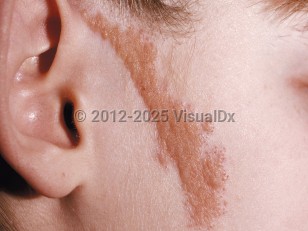Nevus sebaceus in Child
See also in: Hair and ScalpAlerts and Notices
Important News & Links
Synopsis

Nevus sebaceus (of Jadassohn) is a common congenital hamartoma that is usually present at birth but occasionally may not be noted until childhood or even later. It is considered a subtype of organoid epidermal nevus. It typically presents in infancy as a solitary, hairless, well-demarcated, yellow-tan plaque with a velvety to verrucoid surface. This oval to linear lesion ranges in size from a few millimeters up to a few centimeters and is commonly found on the scalp. Most lesions are sporadic, with rare familial forms reported. There is no ethnic or sex predilection.
Nevus sebaceus may be found on the face or neck, and less frequently, the torso or extremities may be affected. It may be multifocal following the lines of Blaschko. Extensive or multifocal lesions may be associated with the nevus sebaceus syndrome (also known as the sebaceous nevus syndrome; Schimmelpenning syndrome), where it is accompanied by neurological, ocular, cardiovascular, skeletal, and urologic abnormalities. Phakomatosis pigmentokeratotica is the presence of a speckled lentiginous nevus and a linear nevus sebaceus.
The nevus sebaceus lesion tends to enlarge in proportion to the normal development of the patient. In late adolescence through adulthood, numerous secondary neoplasms may arise in a nevus sebaceus. This occurs in a small percentage of cases. They are mostly benign adnexal tumors such as trichoblastoma and syringocystadenoma papilliferum. Trichilemmomas, eccrine poromas, and sebaceomas have also developed. The most commonly encountered malignancy to arise within nevus sebaceus is basal cell carcinoma (BCC). The frequency of BCC in nevus sebaceus is thought to have been previously over-reported, with most BCC cases having been reinterpreted as trichoblastomas. Squamous cell carcinoma and sebaceous carcinoma develop very rarely, and a case each of microcystic adnexal carcinoma and melanoma has been reported.
Nevus sebaceus may be found on the face or neck, and less frequently, the torso or extremities may be affected. It may be multifocal following the lines of Blaschko. Extensive or multifocal lesions may be associated with the nevus sebaceus syndrome (also known as the sebaceous nevus syndrome; Schimmelpenning syndrome), where it is accompanied by neurological, ocular, cardiovascular, skeletal, and urologic abnormalities. Phakomatosis pigmentokeratotica is the presence of a speckled lentiginous nevus and a linear nevus sebaceus.
The nevus sebaceus lesion tends to enlarge in proportion to the normal development of the patient. In late adolescence through adulthood, numerous secondary neoplasms may arise in a nevus sebaceus. This occurs in a small percentage of cases. They are mostly benign adnexal tumors such as trichoblastoma and syringocystadenoma papilliferum. Trichilemmomas, eccrine poromas, and sebaceomas have also developed. The most commonly encountered malignancy to arise within nevus sebaceus is basal cell carcinoma (BCC). The frequency of BCC in nevus sebaceus is thought to have been previously over-reported, with most BCC cases having been reinterpreted as trichoblastomas. Squamous cell carcinoma and sebaceous carcinoma develop very rarely, and a case each of microcystic adnexal carcinoma and melanoma has been reported.
Codes
ICD10CM:
D23.9 – Other benign neoplasm of skin, unspecified
SNOMEDCT:
707136009 – Nevus sebaceous
D23.9 – Other benign neoplasm of skin, unspecified
SNOMEDCT:
707136009 – Nevus sebaceous
Look For
Subscription Required
Diagnostic Pearls
Subscription Required
Differential Diagnosis & Pitfalls

To perform a comparison, select diagnoses from the classic differential
Subscription Required
Best Tests
Subscription Required
Management Pearls
Subscription Required
Therapy
Subscription Required
References
Subscription Required
Last Reviewed:02/13/2020
Last Updated:07/16/2023
Last Updated:07/16/2023
Nevus sebaceus in Child
See also in: Hair and Scalp
